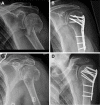Open reduction and internal fixation of displaced proximal humeral fractures. Does the surgeon's experience have an impact on outcomes?
- PMID: 30399160
- PMCID: PMC6219805
- DOI: 10.1371/journal.pone.0207044
Open reduction and internal fixation of displaced proximal humeral fractures. Does the surgeon's experience have an impact on outcomes?
Abstract
Introduction: To evaluate outcomes following open reduction and internal fixation of displaced proximal humeral fractures with regards to the surgeon's experience.
Material and methods: Patients were included undergoing ORIF by use of locking plates for displaced two-part surgical neck type proximal humeral fractures. Reduction and functional outcomes were compared between procedures that were conducted by trauma surgeons [TS], senior (>2 years after board certified) trauma surgeons [STS] and trauma surgeons performing ≥50 shoulder surgeries per year [SS]. Quality of reduction was measured on postoperative x-rays. Functional outcomes were assessed by gender- and age-related Constant Score (nCS). Secondary outcome measures were complication and revision rates.
Results: Between 2002-2014 (12.5 years) n = 278 two-part surgical neck type humeral fractures (AO 11-A2, 11-A3) were included. Open reduction and internal fixation was performed with the following educational levels: [TS](n = 68, 25.7%), [STS](n = 110, 41.5%) and [SS](n = 77, 29.1%). Functional outcome (nCS) increased with each higher level of experience and was significantly superior in [SS] (93.3) vs. [TS] (79.6; p = 0.01) vs. [STS] (83.0; p = 0.05). [SS] (7.8%) had significantly less complications compared with [TS] (11.3%; p = 0.003) and [STS](11.7%; p = 0.01) moreover significantly less revision rates (3.9%) vs. [TS](8.2%) and [STS](7.4%) (p<0.001). Primary revision was necessary in 13 cases (4.7%) due to malreduction of the fracture.
Conclusion: Quality of reduction and functional outcomes following open reduction and internal fixation of displaced two-part surgical neck fractures are related to the surgeon's experience. In addition, complications and revision rates are less frequent if surgery is conducted by a trauma surgeon performing ≥50 shoulder surgeries per year.
Conflict of interest statement
The authors have declared that no competing interests exist.
Figures



References
-
- Tepass A, Blumenstock G, Weise K, Rolauffs B, Bahrs C. Current strategies for the treatment of proximal humeral fractures: an analysis of a survey carried out at 348 hospitals in Germany, Austria, and Switzerland. Journal of shoulder and elbow surgery. 2013;22(1):e8–14. 10.1016/j.jse.2012.04.002 . - DOI - PubMed
-
- Haasters F, Siebenburger G, Helfen T, Daferner M, Bocker W, Ockert B. Complications of locked plating for proximal humeral fractures-are we getting any better? Journal of shoulder and elbow surgery. 2016;25(10):e295–303. - PubMed
MeSH terms
LinkOut - more resources
Full Text Sources
Medical

